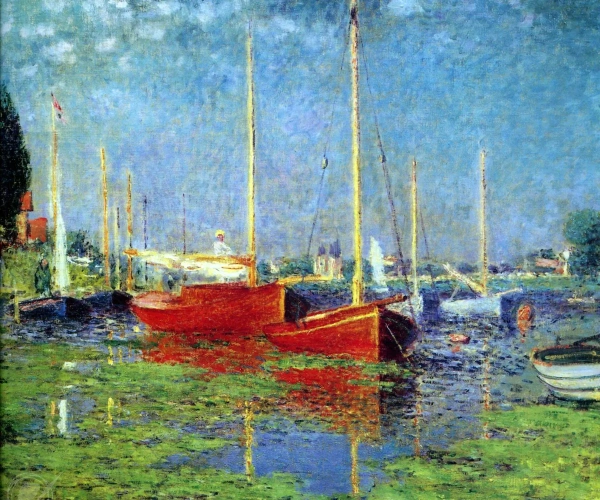The Red Boats, Argenteuil
"The Red Boats, Argenteuil," a captivating work by Claude Monet, masterfully encapsulates the essence of Impressionism, a movement that revolutionized the art world in the late 19th century. Created in 1875, this painting is a vivid testimony to Monet's enduring fascination with the interplay of light, color, and nature. The scene is set in Argenteuil, a suburban town on the outskirts of Paris, which became an inspirational haven for Monet during this period. Monet's distinctive brushwork is immediately apparent in "The Red Boats, Argenteuil." He employs quick, loose strokes to create a sense of spontaneity and movement, capturing the fleeting effects of light and its reflections on the water's surface. The boats, painted in a striking shade of red, contrast beautifully against the blue and green hues of the water and the gentle gradients of the sky. This use of color is not just a visual choice but also an emotive one, reflecting Monet's desire to evoke feelings and moods through his palette.
The composition of the painting is equally notable. Monet does not center the boats but rather places them off to the side, inviting the viewer's eye to wander through the scene, following the gentle ripples of the water and the soft outlines of the buildings in the background. This seemingly casual arrangement is, in fact, a calculated effort to capture a moment as it is, unadorned and true to life.
Furthermore, "The Red Boats, Argenteuil" is a testament to Monet's pioneering role in the Impressionist movement. His focus on outdoor scenes, the changing qualities of natural light, and the use of color to convey emotion were radical departures from the conventions of academic painting. This painting, among others, challenged traditional notions of composition, perspective, and subject matter, paving the way for modern art as we know it.
In sum, Monet's "The Red Boats, Argenteuil" is not just a beautiful landscape painting; it is a bold statement about the power of observation and the artist's role in capturing the ephemeral beauty of the world around us. Its enduring appeal lies in its ability to evoke a sense of place and time, inviting the viewer to experience a fleeting moment through the eyes of a master."







No Comments Yet...